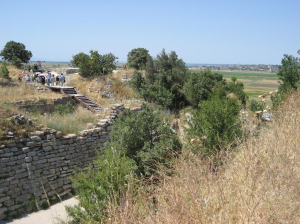This post originally appeared on For Winter Nights Book Review Blog.
While my purpose in writing Hand of Fire was to tell a compelling tale, I also wanted to reflect accurately the history of this time and place. Which begs the question: Is Troy the stuff of mythology or does it have a basis in history? There are actually several layers to that question. For now, I will focus on the actual city of Troy itself. That’s the clearest piece of the puzzle. Elsewhere along my virtual book tour I talk about whether the Trojan War actually happened which is kind of the second step in the question.
Can we say with reasonable certainty that we know where the real city of Troy is located and what life was like there during the period of a possible Trojan War, that is, the Late Bronze Age?

In the late 1800s, a determined, if sometimes dishonest, German named Schliemann used his private fortune to pursue his dream to find Troy. We do owe him thanks for finding the place that would gradually be confirmed as Troy, although since Frank Calvert was the one who pointed out the location, but didn’t have the money to dig it, this ‘discovery’ was probably just a matter of time. The idea was already afloat. Given all the overly enthusiastic, highly destructive digging Schliemann did, his contribution to establishing the historical foundation of Troy is a bit of a mixed blessing.
The main objection to Schliemann’s identification of the mound he dug up as Troy was that the city he uncovered was too small. If it were really the major city that controlled the wealth and trade moving through the straits between the Mediterranean and the Black Sea, known to the Greeks as the Hellespont, what Schliemann showed the world seemed pretty puny. There were believers and many skeptics.
One other inheritance from Schliemann was his assumption that the culture of Troy was Greek and akin to the Mycenaean sites in Greece that he and others were uncovering at this time. He never imagined that any ancient culture in Turkey could possibly be grand enough for his beloved Homer. He was prejudiced, pure and simple, but it is true no grand archaeological sites of the correct period had been discovered in Turkey yet, so his bias had no sites to act as counterweight.
Flash forward past some interim digging by two different archaeologists who both helped and hurt. The story of Troy resumes with Manfred Korfmann, who in 1988 until his death in 2005 (after which work at Troy has continued), gave the site of Troy a modern makeover. Some of his best finds, by the way, came from Schliemann’s dump pile.
Most important, Korfmann used contemporary tools like satellites and geophysical prospection to “look” beneath the ground and discover, without digging, the overall layout of the walls of the elusive lower city. With the pictures revealing the pattern of walls and thus demonstrating an overall size consistent with an important trade center, the problem of Troy being too small was solved. Korfmann demonstrated that up to now only Troy’s citadel had been excavated, which represented only a small portion of the city, as you would expect.
Among the many other things this modern dig has shown about Troy, the point of greatest importance to me is that Troy was an Anatolian city not a Greek one. Ancient Anatolia (modern Turkey more or less) stretched from the west coast along the Aegean into Syria to the east. In the Late Bronze Age, Anatolia was dominated by the Hittite Empire, and Troy was an allied, often vassal, state to the Hittites. Modern archaeology had in the intervening years uncovered a grander world than Schliemann would ever have attributed to Turkish soil—an empire that rivaled Egypt and Assyria and that left behind giant archives. In those clay tablet archives are treaties and letters pertaining to Troy (which the Hittites called Wilusa, a version of Ilion, the other Greek name for Troy). Now we can not only be certain this site is Troy, we can also surmise a great deal about this city’s daily life, religion, politics and intrigue because Troy and the rest of Anatolia shared a common cultural tradition. The tablets are full of details of treaties, rituals, and daily life. I used that information to create a historically accurate Briseis, even if, as I must admit, she herself may have originally been the figment of the bard’s imagination. Now she’s a flesh and blood woman with a dramatic life in a region that is to us both exotic and marvelous.
In writing this post I pulled evidence from three works:
 The Trojan War: A Very Short Introduction (Very Short Introductions)
The Trojan War: A Very Short Introduction (Very Short Introductions)by Eric Cline (highly recommended)
Was There a Trojan War? by Manfred Korfmann
Troia in Light of New Research, a lecture by Manfred Korfmann.


